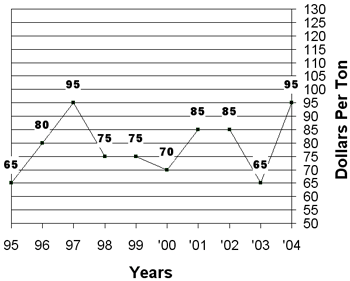Production Update:
Prussic Acid Poisoning: Prussic acid and nitrate poisoning are
similar in that both interfere with the ability of the blood to carry
oxygen. Also, accumulation of the toxic compounds in the plant is associated
with reduced crop growth from frost, drought, and herbicide application.
However, prussic acid poisoning is most commonly associated with sorghum
and sudangrass and their hybrids. Prussic acid forming compounds are highest
in concentration in the top growth and new shoots. The risk of prussic
acid poisoning can be reduced by only grazing plants taller than 24 inches,
and allowing 1- 2 weeks after a frost to graze. Prussic acid poisoning
is rarely a problem with hay since the poison producing compounds dissipate
during drying.
Insect Management: Spider mites do not often cause wide
spread damage to alfalfa grown for hay and damage may be associated with
water stress. Spider mites feed by inserting long needle-like mouth parts
into leaves removing plant sap causing a yellow stippling on leaves and
leaves are covered with webbing. Severe feeding causes necrosis, leaves
turn brown, become dry and drop from the plant. Infestations are usually
confined to the lower leaves so damage starts in the lower plant canopy
moving upward. Feeding damage reduces yield, quality and retards regrowth.
Spider Mite Species in Western Arizona & Southern California include:
carmine spider mite (T. cinnabarinus Boisdival) (
picture);
desert spider mite (T desortorum Banks); strawberry mite (T. turkestani
Ugarov & Nikolski) (
picture),
and twospotted spider mite (Tetranychusurticae Koch) (
adult
picture, feeding
damage). Avoid using pyrethroid insecticides for alfalfa pest control;
they can flare spider mite infestations. Minimizing crop stress through
improved irrigation; when fields are watered, infestations often clears
up in a few days. When severe infestations occur, sulfur may be used to
suppress the populations.
Weed Control: Red sprangletop (picture
of seedling) has become widespread because it overwinters and is not
controlled with trifluralin or eptam and because postemergence applications
of poast are ineffective on this weed. The highest labeled rate of slect/prism
will produce moderate to good control of sprangletop.
| Market Summary |
High
|
Low
|
Average
|
Off grade
|
| Past 2 Weeks ( 2004) |
100
|
90
|
95
|
70-85
|
| Last Year ( 2003) |
70
|
60
|
65
|
50-60
|
10 Year Summary (June 14, to June 27, 1995-2004):

Issued in furtherance of Cooperative Extension work, acts of May 8 and June 30, 1914, in cooperation with the U.S. Department of Agriculture, James A. Christenson, Director Cooperative Extension, College of Agriculture and Life Sciences, The University of Arizona.
The University of Arizona is an equal opportunity, affirmative action institution. The University does not discriminate on the basis of race, color, religion, sex, national origin, age, disability, veteran status, or sexual orientation in its programs and activities.
Any products, services, or organizations that are
mentioned, shown, or indirectly implied in this web document do not imply
endorsement by The University of Arizona.
Information provided by:
Barry Tickes, btickes@ag.arizona.edu Extension Agent, Yuma County
Michael Ottman, mottman@ag.arizona.edu Agronomy Specialist
College of Agriculture, The University of Arizona.
Eric Natwick, etnatwick@ucdavis.edu UCCE Imperial County - Farm Advisor
University of California, Davis, CA.
Forages: Crop Mgmt | Soil Mgmt | Irrigation | Alfalfa Reports | Insects | Diseases | Weeds | Pesticides
Home | Other Crops | Forages
For more Arizona Production Ag Information:
Home | Cotton | Veggies| Forages | Grains | Citrus | Crop x Crop | Insects | Diseases| Weeds | Pesticides | News | Weather | Research | Photos | Contacts | General Info. | Site Map
Copyright © 2001 University of Arizona,
College of Agriculture and Life Sciences
Webmaster: Al Fournier (fournier@ag.arizona.edu)